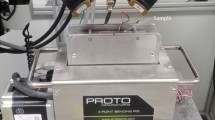Abstract
Fatigue life tests play a central role in the design of mechanical systems, as the structural reliability estimation depends heavily on the fatigue strength of material, which need to be determined by experiments. The classical statistical analysis, however, can lead to results of limited usefulness when the number of specimens on test is small. Instead, this approach can potentially give more accurate estimates by applying the overall sample at each stress level. For the case of lognormal distribution, equivalent conversion of fatigue life is presented first. Then, P–S–N curve parameters are obtained based on sample aggregation principle. Furthermore, simulation test and experimental test are conducted to validate the proposed method, respectively, demonstrating that this method can sensibly outperform conventional ones. Finally, determination of minimum number of specimens in fatigue testing is presented, which can obtain P–S–N curves with a certain accuracy.








Similar content being viewed by others
References
O.H. Basquin, The exponential law of endurance tests. ASTM 10, 625–630 (1910)
ISO B S, Metallic materials—fatigue testing—statistical planning and analysis of data (2003)
Standard A. E739, Standard practice for statistical analysis of linear or linearized stress–life (S–N) and strain–life (ϵ–N) fatigue data (2015)
L. D’Angelo, M. Rocha, A. Nussbaumer, et al., S-N-P fatigue curves using maximum likelihood, in ECCS European Convention for Constructional Steelwork (2014)
N. Stojković et al., Algorithm for determination of s-n curves of the structural elements subjected to cyclic loading. Facta Univ. Ser. Archit. Civil Eng. 16(1), 81–91 (2018)
S.A. Faghidian, A. Jozie, M.J. Sheykhloo et al., A novel method for analysis of fatigue life measurements based on modified Shepard method. Int. J. Fatigue 68(68), 144–149 (2014)
X.W. Liu, D.G. Lu, P.C.J. Hoogenboom, Hierarchical Bayesian fatigue data analysis. Int. J. Fatigue 100, 418–428 (2017)
M. Guida, F. Penta, A Bayesian analysis of fatigue data. Struct. Saf. 32(1), 64–76 (2010)
T.T. Pleune, O.K. Chopra, Using artificial neural networks to predict the fatigue life of carbon and low-alloy steels. Nucl. Eng. Des. 197(1–2), 1–12 (2000)
T. Bučar, M. Nagode, M. Fajdiga, An improved neural computing method for describing the scatter of S-N, curves. Int. J. Fatigue 29(12), 2125–2137 (2007)
Y. Al-Assaf, H.E. Kadi, Fatigue life prediction of composite materials using polynomial classifiers and recurrent neural networks. Compos. Struct. 77(4), 561–569 (2007)
T. Bučar, M. Nagode, M. Fajdiga, A neural network approach to describing the scatter of S-N curves. Int. J. Fatigue 28(4), 311–323 (2006)
H. Fu, Linear variance regression analysis. Acta Aeronaut. Astronaut. Sin. 15(3), 295–302 (1994)
H. Fu, C. Liu, Small sample test method for S-N and P-S-N curves. J. Mech. Strength 28(4), 552–555 (2006)
L. Xie, J. Liu, N. Wu et al., Backwards statistical inference method for P–S–N curve fitting with small-sample experiment data. Int. J. Fatigue 63(63), 62–67 (2014)
P.C. Gope, Determination of sample size for estimation of fatigue life by using Weibull or log-normal distribution. Int. J. Fatigue 21(8), 745–752 (1999)
P.C. Gope, Determination of minimum number of specimens in SN testing. Trans. Am. Soc. Mech. Eng. J. Eng. Mater. Technol. 124(4), 421–427 (2002)
H. Fu, A confidence lower limit of population percentile. J. Beijing Univ. Aeronaut. Astronaut. 3, 1–8 (1990)
L. Xie, Principle of sample polymerization and method of p-s-n curve fitting. J. Mech. Eng. 49(15), 96–104 (2013)
P.H. Wirsching, Statistical summaries of fatigue data for design purposes. New York. NASA Contractor Report 3697 (1983)
P.H. Wirsching, Y.T. Wu, Probabilistic and statistical methods of fatigue analysis and design, in Pressure Vessel and Piping Technology 1985. A Decade of Progress 1985, ed. by C. (Raj) Sundararajan (American Society of Mechanical Engineers, New York, 1985), pp. 793–819
S. Zhu, X. Fang, M. Wu, et al., Mechanical Engineering Material Performance Data Sheet (China Machine Press, Beijing, 1994)
Author information
Authors and Affiliations
Corresponding author
Rights and permissions
About this article
Cite this article
Tan, X. P–S–N Curve Fitting Method Based on Sample Aggregation Principle. J Fail. Anal. and Preven. 19, 270–278 (2019). https://doi.org/10.1007/s11668-019-00586-1
Received:
Published:
Issue Date:
DOI: https://doi.org/10.1007/s11668-019-00586-1




